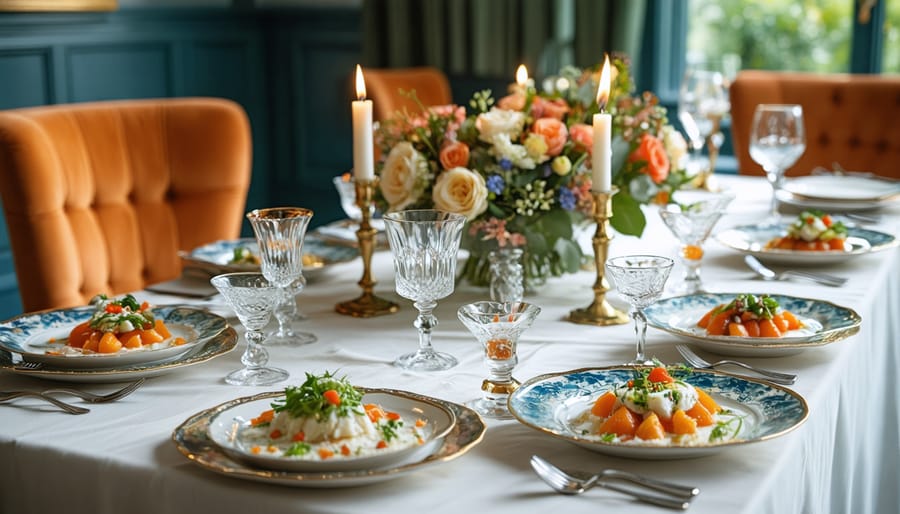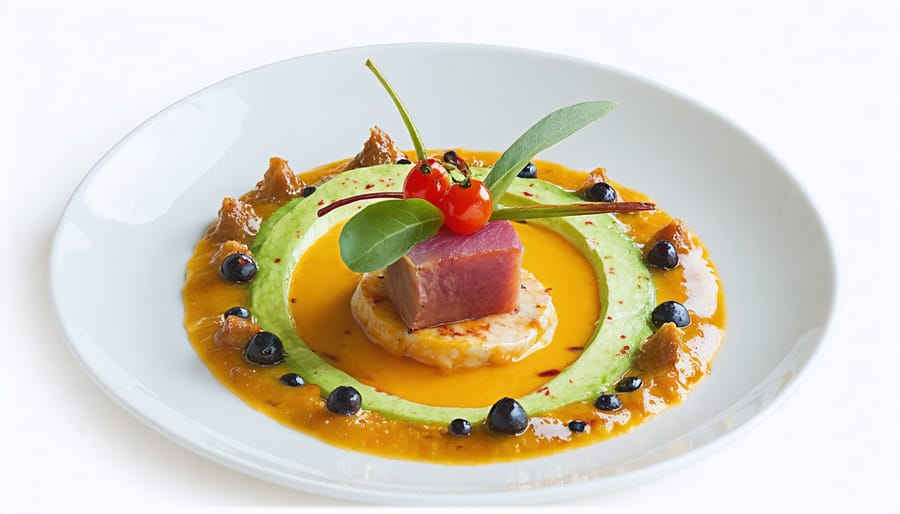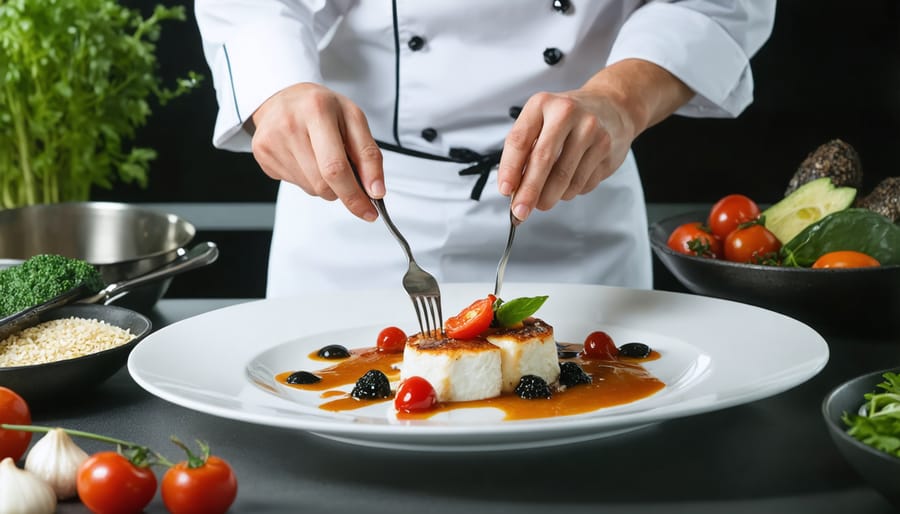
A culinary experience transcends the simple act of eating – it’s an immersive journey that engages all your senses and creates lasting memories. Picture the sizzle of a perfectly seared steak, the aromatic dance of fresh herbs, and the artistic presentation of a thoughtfully plated dish. Whether you’re savoring a seven-course tasting menu at a Michelin-starred restaurant or gathering around a rustic farm table for a family-style feast, these moments transform ordinary meals into extraordinary adventures.
The magic lies in the details: the warm welcome of attentive service, the carefully curated wine pairings, the stories behind each dish, and the company you share it with. It’s about discovering new flavors, understanding different cooking techniques, and appreciating the cultural heritage behind various cuisines. A true culinary experience connects you not just to the food on your plate, but to the passionate people who created it, the traditions that inspired it, and the communities that celebrate it.
Think of it as dining with intention – where every element, from the ambiance to the final bite of dessert, is designed to create a memorable journey that nourishes both body and soul.
The Art of Mindful Eating
Beyond Just Taste
A true culinary experience engages all your senses, creating a symphony of elements that dance together perfectly. While taste is undoubtedly important, it’s just one part of what makes dining truly memorable. Think about the last time a beautifully plated dish made you pause to take a photo, or when the aroma of fresh herbs and spices drew you into a restaurant before you even saw the menu.
The visual presentation of food can transform a simple meal into an artistic expression. It’s why chefs spend so much time carefully arranging each element – they understand that we eat with our eyes first. Incorporating a mindful eating practice helps us appreciate these visual details even more.
The ambiance plays a crucial role too. Whether it’s soft lighting, thoughtfully chosen music, or the gentle clinking of glasses, these environmental elements create the perfect backdrop for your meal. Even the temperature of the room and the comfort of your seating contribute to the overall experience.
Remember those family dinners where the conversation and laughter were just as nourishing as the food? That’s because a true culinary experience is as much about the company and atmosphere as it is about what’s on your plate.

The Social Connection
There’s something magical about gathering around a table with loved ones, sharing not just food but also stories, laughter, and meaningful connections. The social aspect of dining transforms a simple meal into a truly memorable culinary experience. Whether it’s a casual Sunday brunch with friends or an elaborate dinner party, the conversations and connections we forge over food add layers of richness to our dining moments.
Think about your most cherished food memories – chances are they involve other people. That’s because humans are naturally social creatures, and food has always been a powerful catalyst for bringing people together. When we share meals, we’re not just nourishing our bodies; we’re creating bonds, celebrating traditions, and making memories that last a lifetime.
The art of conversation while dining also enhances our appreciation of the food itself. Discussing flavors, sharing opinions about dishes, and learning about others’ food experiences can open our minds to new perspectives and deepen our understanding of different culinary traditions. It’s this beautiful dance between social connection and gastronomy that makes shared meals so special and transformative.

Creating Your Own Culinary Adventure
Setting the Stage
The magic of a culinary experience begins long before the first bite. Just as a theater sets the mood before the curtain rises, your dining space should create anticipation and excitement. Start by considering your lighting – soft, warm illumination creates an inviting atmosphere that makes everyone feel at ease. I learned this trick from my grandmother, who always dimmed the lights and lit candles for special family dinners.
When it comes to fine dining essentials, your table setting speaks volumes. Layer your place settings with care – a charger plate beneath your dinner plate adds elegance, while properly arranged cutlery guides your guests through each course. Fresh flowers or seasonal centerpieces bring life to the table, but keep them low enough for easy conversation.
Music plays a subtle yet crucial role in setting the mood. Choose instrumental pieces that complement rather than compete with conversation. The right playlist can transform a simple dinner into an memorable evening.
Don’t forget the power of scent – the aroma of fresh herbs or bread baking can create an welcoming atmosphere that builds anticipation. Just be mindful not to overwhelm the space with competing fragrances that might interfere with the food’s natural aromas.
Remember, preparation is key. Set your table well in advance, chill your wines to the perfect temperature, and ensure you have everything within reach. This allows you to be present and enjoy the experience alongside your guests.
The Story Behind the Plate
Every dish has a story waiting to be discovered, and understanding these stories transforms a simple meal into a captivating culinary journey. When you know that the saffron in your paella was hand-harvested from crocus flowers in Spanish fields, or that your coffee beans were carefully selected from a small family farm in Colombia, the flavors become more meaningful.
The magic of a true culinary experience lies in connecting with these origins. It’s about understanding why certain cooking techniques have been passed down through generations – like the slow-cooking method of a traditional Italian ragù or the precise knife skills required for authentic Japanese sushi. These aren’t just cooking methods; they’re preserved pieces of cultural heritage.
Take a moment to imagine the journey of ingredients from farm to plate. That fresh basil in your pesto might have been grown in a local greenhouse, while the pine nuts were gathered from Mediterranean stone pines. Each component brings its own story, its own terroir – that special combination of soil, climate, and tradition that makes it unique.
Learning these stories doesn’t just make us better cooks; it makes us more conscious consumers and more appreciative diners. Whether you’re cooking at home or dining out, taking time to understand the heritage behind your meal adds an enriching layer to your culinary experience.
From Restaurant to Home
Chef-Inspired Techniques
Ever watched a professional chef and wondered how they make everything look so effortless? The good news is that you can bring that same finesse to your own kitchen with some simple mindful kitchen techniques. Let’s start with mise en place – French for “everything in its place.” Before cooking, gather and prep all ingredients, creating a calm, organized workspace that lets you focus on the magic of cooking rather than frantically searching for ingredients.
Temperature control is another game-changer. Instead of immediately cranking up the heat, try starting with a cold pan for delicate items like eggs or fish. For perfectly seared meat, pat it dry and let it come to room temperature before cooking. These small steps make a huge difference in the final result.
Learn to trust your senses. Professional chefs rarely rely on timers alone – they use their eyes, ears, and nose to guide them. Listen for the sizzle changing pitch, watch for color transformations, and smell when aromatics have reached their peak. Touch is crucial too; developing a feel for when meat is done by gently pressing it will transform your cooking confidence.
Finally, embrace the power of proper seasoning. Rather than waiting until the end, season in layers throughout the cooking process. This builds depth and complexity that elevates even the simplest dishes into memorable culinary experiences.

Presentation Magic
They say we eat with our eyes first, and I couldn’t agree more! Creating visually appealing dishes doesn’t require culinary school training – just a few simple tricks can transform your plates from ordinary to extraordinary. Let me share some of my favorite presentation tips that never fail to impress dinner guests.
Start with the basics: choose a plate that complements your food’s colors and portions. White plates are my go-to canvas, allowing the food to take center stage. When plating, think in odd numbers – groups of three or five elements tend to look more artistic and intentional than even numbers.
Height adds drama to any dish. Try layering components or propping proteins against vegetables or starches. For example, lean a piece of salmon against a mound of rice, or stack roasted vegetables in a neat tower. A simple sprinkle of fresh herbs, microgreens, or edible flowers instantly elevates the look of any dish.
Don’t forget the power of sauce presentation! Instead of drowning your dish, try creating elegant drizzles or dots using the back of a spoon or a squeeze bottle. One of my favorite tricks is placing a small dollop of sauce on the plate and dragging it with the back of a spoon to create an artistic sweep.
Remember, less is often more. Keep some negative space on the plate – it helps the eye focus on your beautifully presented food and creates that professional restaurant feel right at home.
A culinary experience is so much more than just eating – it’s about creating moments that engage all your senses and leave lasting memories. Whether you’ve explored exotic street food markets, mastered a challenging recipe, or shared a thoughtfully prepared meal with loved ones, each experience adds a unique chapter to your food journey.
Remember, you don’t need to be a professional chef or travel to far-off destinations to create meaningful culinary experiences. Start small by experimenting with new ingredients in your kitchen, hosting themed dinner parties, or exploring local food festivals. The key is to approach each food-related moment with curiosity and intention.
Consider documenting your culinary adventures through photos or a food journal. Share your experiences with friends and family, and don’t be afraid to step out of your comfort zone. Sometimes the most memorable food moments come from unexpected places or simple preparations done with care and attention.
As you continue your culinary journey, focus on what brings you joy in the kitchen and at the table. Whether it’s mastering the perfect sourdough bread, exploring farmers’ markets, or creating special dinner traditions with your family, your personal culinary experience is waiting to unfold.
Take that first step today – plan a special meal, sign up for a cooking class, or simply try a new recipe. Your next unforgettable food moment is just around the corner.



